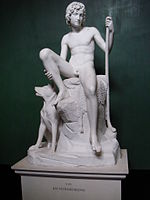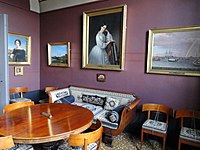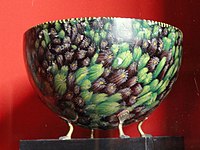Thorvaldsen Museum
Thorvaldsen's Museum is a solo artist museum in Copenhagen , Denmark dedicated to the art of the Danish classicist sculptor Bertel Thorvaldsen (1770–1844). He lived and worked for most of his life (1796–1838) in Rome . The museum is located on the small island of Slotsholmen in central Copenhagen, not far from Christiansborg Palace . Designed by the architect Gottlieb Bindesbøll , the building was constructed from 1838 to 1848 after a public collection of funds in 1837.
The building
The building is heavily inspired by ancient Greek architecture and built around a courtyard where the artist is buried. It is particularly noteworthy for the unique use of color both indoors and outdoors. Each room in the museum has a unique ceiling decoration in a grotesque style. The outside is adorned with a frieze depicting Thorvaldsen's return from Rome in 1838, made by Jørgen Valentin Sonne . The idea of designing the facades with life-size figures came from Bindesbøll. Scenes of this homecoming are depicted on the individual walls: the crowd celebrating the sculptor; Unloading his work from the frigate Rota; The transfer of the work to the museum.
Collections
The museum displays an extensive collection of the artist's works in marble and plaster, as well as the original plaster models that were used in the manufacture of bronzes and marble, statues and reliefs that can now be found in museums, churches and other locations around the world are located. The museum also features paintings, Greek, Roman and Egyptian antiquities, drawings and prints that Thorvaldsen collected in his life, as well as a wide range of personal items that he used in his work and everyday life.
Basement
There are three permanent mini-exhibitions in the south corridor: about Thorvaldsen's life with objects he owned, about his technology and workshop, and about early portrait busts. His award-winning works for the academy and a selection of model designs are located in the west corridor. Thorvaldsen's collection of plaster casts is on display in the north corridor. There are also seven smaller rooms for special exhibitions.
ground floor
In the vestibule on the first floor there are Thorvaldsen's plaster models for historical figures that can be seen in various European cities. The so-called Kristussal, which shows the plaster models for the figures of Christ and the apostles in the Church of Our Lady in Copenhagen, is also located on the ground floor .
The west corridor houses the museum shop, while in the north corridor the plaster models for the figure of John the Baptist are shown in the triangular gable above the main entrance of the Frauenkirche. In the south corridor, plaster models of various figures and reliefs are exhibited, which are located in the other 21 smaller rooms on the floor. These mainly show motifs from ancient mythology. Thorvaldsen's grave is located in the atrium on the first floor.
First floor
The upper floor mainly shows two permanent exhibitions as well as Thorvaldsen's painting and sculpture collection. Thorvaldsen's marble friezes “Alexander den Stores indtog i Babylon” are exhibited in the west corridor. This is a reduced version of the work from 1812. The south and north corridors house further plaster models of various figures and reliefs, which are exhibited on the ground floor.
In one room, furnishings from Thorvaldsen's professor's apartment in the Art Academy at Charlottenborg Palace are shown.
gallery
Johan Christian Clausen Dahl : Grotto in the Bay of Naples. - Paintings from Thorvaldsen's own collection
Franz Ludwig Catel : Night piece after the final scene of Chateaubriand's novella “René” - painting from Thorvaldsen's own collection
Web links
Coordinates: 55 ° 40 ′ 36.1 ″ N , 12 ° 34 ′ 41.9 ″ E














